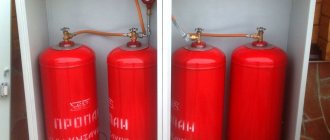Is it possible to move a gas water heater to another location yourself?
The installation of gas water heating equipment in premises is subject to high standards and strict requirements, regulated by SNiP 42-01-2002 and SP 42-101-2003.
Additionally, several provisions from the Decree of the Government of the Russian Federation dated July 21, 2008 No. 549 “On the procedure for supplying gas to meet the household needs of citizens” are taken into account. According to the listed regulatory and regulatory documents, the transfer of a gas water heater to another location must be carried out in compliance with the following conditions:
- the work will be performed by a specialist with the necessary permission;
- the connection will be made in accordance with the existing project.
Accordingly, independent dismantling and reconnection of gas equipment is considered a gross violation of regulations. If the work will be carried out by a specialist, for example a representative of the Gas Service, then the change in location must be agreed upon, as evidenced by the project indicating the new location of the dispenser.
Frequently asked questions about moving a gas water heater
The process of dismantling and reinstalling the boiler itself is not complicated. It is enough to have a minimum set of tools, a hammer drill or a drill, to literally do it in 15-20 minutes. move the speaker to another wall.
It is not surprising that many owners of apartments and private houses ask whether it is possible to independently change the location of the instantaneous gas water heater.
Below are the most common situations and the rules associated with them.
It is worth noting that the fine for moving a gas water heater depends on how the violation is assessed. For an administrative offense committed in domestic conditions, you will have to pay from 2 to 8 thousand rubles. If the changes lead to damage to property or loss of life, a fine of 35-40 thousand rubles follows. or criminal liability in the form of imprisonment for 2 years.
Is it permissible to move the speaker within the same room?
Yes, transfers are possible under certain conditions. The geyser can be moved to a distance not exceeding 1.5 m from its original location. In this case, several conditions must be met:
- installation of gas equipment in adjacent rooms is prohibited; connection is allowed only within the boundaries of the room indicated in the project;
- You cannot install the speaker on another wall (transfer is permissible along one wall).
Any specialist with the appropriate license can move the gas water heater to another location. For example, a representative of a company that sold a water heater. There is no need to make a new project and carry out approvals in the described case.
Moving a gas water heater to another wall within the same room is possible only after making changes to the technical documentation. This situation is associated with the need to make adjustments to the passage of the gas pipe. Installation of equipment on load-bearing structures of a building is prohibited.
Is it possible to move the speaker from the kitchen to the bathroom?
No, this is prohibited! In old Khrushchev houses, this arrangement was determined by the design documentation. A gas water heater was installed in the bathroom. Modern standards, although in the form of recommendations, indicate that placement in rooms with high humidity is strictly prohibited.
Despite the lack of direct and clear wording, it can be concluded from the provisions that the bathroom is not suitable for the location of the boiler. In any case, gas workers will not allow you to install a water heater in the bathroom legally.
Source: https://kirpich174.ru/publications/mozhno-li-perenesti-gazovuju-kolonku-v-drugoe.html
Stages of moving a gas boiler
The transfer of a gas device consists of two main stages: dismantling the boiler from the old location and installing it in a new one.
To ensure that there is a minimum period of time between these actions, you should prepare the new room in advance for the installation of a gas boiler:
- bring water and gas pipelines to a new location;
- place an outlet next to the future unit if it is missing;
- prepare the installation site: hang a shield made of fireproof material (metal) on the wall for a mounted unit, put a fireproof base on the floor or form a concrete screed for a floor-mounted version;
- make a hole in the ceiling or wall for the chimney;
- remove flammable items from the room.
You also need to make sure that the volume of the room matches the power of the gas boiler. It cannot be less than 7.5 m³ - this is the minimum permissible volume of the room in which a gas unit is allowed to be installed. Ceiling height – from 2 m and above.
…
Dismantling a gas boiler
Dismantling of a gas boiler is carried out in the following stages:
- The gas pipeline is shut off.
- Flush the entire heating system.
- Turn off the boiler from the outlet, disconnect the chimney, water pipes and sewerage from the unit.
- Remove the attachment from the brackets.
Unit installation
The main stages of installing a gas boiler are as follows:
- Preparing the chimney: installing the pipe in a hole with a slight slope towards the street to drain condensate. The coaxial chimney is inserted into the hole and secured with wedges, after which the empty space is filled with cement or foam.
- Using a template for the back wall of a wall-mounted gas boiler, mark the places on the wall for installing the brackets and attach them.
- Wall-mounted models are hung on brackets, and floor-mounted models are placed flat on a fireproof base.
- The boiler pipe is connected to the chimney through a special elbow.
- Connect the heating and water supply system to the unit circuit. If the model is double-circuit, then DHW is also supplied.
- They install a gas pipeline - a metal flexible hose is best, but it must be connected by a gas service representative.
- Plug the device into a power outlet and connect it to ground.
- You can check the system yourself for leaks.
- A specialist is invited to carry out the first start-up of a gas boiler.
Before transferring a heating device, you should once again think about how feasible this is, since such manipulation is not cheap at all. For example, moving a gas boiler to a loggia only makes sense if this room is insulated and will be heated as part of the living area.
Kitchen design with a column: possible options for successful placement
On the one hand, owners of gas or electric water heaters can be considered lucky.
They do not depend on centralized hot water supplies and have the opportunity to use water at the desired temperature all year round.
On the other hand, the design of a kitchen with a speaker installed in it is not always aesthetically pleasing, and in small rooms, for which Khrushchev buildings are famous, the units take up extra space and simply get in the way.
Options for placing speakers in the interior
For a kitchen with a large area, there are practically no problems with determining the location of the speaker. The equipment is installed either directly in front of the water collection point, or on that section of the wall where it is least noticeable.
For a small kitchen in a Khrushchev-era building, options for successful placement of a water heater come down to four possible solutions in which it can be used:
- move to another room, for example, to the bathroom, which the device also serves;
- hide in a furniture set;
- put on display, having previously decorated;
- fit harmoniously into a row of wall cabinets.
Each of the proposed options has the right to exist. And only the owner of the apartment can decide which one to choose, after consulting with specialists. This will require thoughtful design, as well as identification of possible material costs and risks.
Moving the speaker from the kitchen to the bathroom
Khrushchev apartments are famous not only for their tiny kitchens, but also for their far from perfect bathrooms. But if the bathroom in the apartment is combined with a toilet, then you can try to organize a “corner” with a speaker in it. For safety reasons, the location should be chosen so that water cannot enter the housing.
The decisive point is the technical side of the issue regarding the transfer of a gas pipe with a water heater from the kitchen to another room. The fact is that there are certain requirements for the safe operation of equipment, providing for:
- obtaining special permission from gas services;
- organization of ventilation;
- ensuring free access to devices.
For electrical speakers, you will need to perform a separate electrical wiring after consultation and approval of its diagram with specialists.
In most cases, these conditions are difficult to achieve, so owners try to resort to the option of moving water heaters in rare cases. An aesthetic kitchen design with a modern speaker installed instead of an old and bulky device will be much simpler and cheaper.
Speaker in the closet
Manufacturers of water heating systems fully allow the installation of equipment behind furniture facades of wall cabinets. Kitchen design only benefits from this. But in this case, a number of conditions must be met to ensure fire safety and the safety of furniture from destruction.
First of all, the distance between the inner walls of the cabinet in which the column is supposed to be placed must be wider than the body of the water heater by more than ten centimeters.
This helps ensure good natural ventilation and does not interfere with the installation of non-combustible insulation on the side walls of furniture, preventing them from burning, swelling and deterioration.
note
Such a cabinet is made to order, without a back wall, with multiple holes drilled at the bottom for communications, and at the top for a ventilation pipe.
This option is ideal for a kitchen in a Khrushchev-era building with a column installed in the corner. The facade, in this case, creates the illusion of a corner cabinet. Moreover, there is no need to change old furniture. Its design can be refreshed and made more original, for example, by using a lattice door.
Column exposed
The cases of modern speaker models are made not only white, but also black, steel, and also colored. The design of the front panel can be made using multifaceted patterns, paintings or ornaments. For a kitchen in a Khrushchev-era building, such a water heater will be a real “discovery”, although buying it will not be so easy and not too cheap.
Craftsmen suggest decorating the column yourself. You can apply small patterns to the body using stencils and heat-resistant metal paint, or paint it with special enamels in contrasting shades. This will help highlight the water heater from the general background, focusing attention on it. There are many options, the main thing is imagination.
Transferring a geyser: basic requirements and transfer procedure | Heat monster
The official transfer of the gas water heater is dictated by special provisions of SNiP and in almost all cases is possible only after a number of appropriate approvals. Today, the gas water heater is being replaced by other water heating devices, but sometimes it is more economical and convenient to use a gas water heater, which, if necessary, can be moved to another location.
Scheme of a gas storage water heater.
Moving a speaker in an apartment: requirements and recommendations During the construction of “Stalinist” type houses, the rules were less severe, so according to the technical conditions, speakers were installed, for example, in bathrooms.
In accordance with modern rules, gas water heaters cannot be installed in bathrooms.
Important
If you want to move a gas water heater from the bathroom, where it was installed when the building was commissioned, for example, to the kitchen, then you will need to coordinate the issue with the organization for the operation of the gas facility and with the design organization.
Classic water heater installation diagram.
Apartment owners often ask the question whether it is possible to move a gas heater from the kitchen or bath to the hallway. In most cases, this is done in order to free up a small part of the space in the room. In accordance with the current rules, it is possible to move a gas water heater into the corridor if a number of requirements are met, namely:
- the corridor room should be wide enough. Moving the speaker will be allowed only if the distance between the equipment (its most protruding parts) and the opposite wall of the room is at least 1 m;
- the height of the room into which the speaker is planned to be moved must be at least 2 m;
- the volume of the room into which the geyser will be transferred must be at least 7.5 m³. When moving or installing two devices - at least 13.5 m³;
- a ventilation duct must be provided in the room where the column is being transferred;
- Do not install a gas water heater above stoves or other sources of open fire;
- When installing a geyser, it must be provided with a separate tap.
These are the main requirements that are contained in the officially approved rules and regulate the procedure for moving a gas water heater. It is prohibited to transfer the column without the appropriate permissions. It is necessary to obtain permits and invite a specialist from the gas company to your home who will carry out all the work.
Moving a geyser in a house or apartment: basic rules
Water heater operation diagram.
There are also a number of basic rules for installing gas appliances of any type, which must also be followed when carrying out the transfer. The speaker must be installed on the wall in a vertical position.
The equipment must be properly secured and gas and water connections must not be used as a support when mounted on a wall.
In the process of transferring a gas water heater, flexible connecting hoses are used.
The easiest way is to coordinate and move gas equipment to a distance of no more than 1.5 m along the same wall where it was installed previously.
If you need to move the column to a greater distance from the location provided for by the project, coordination will require much more effort and time. According to the law, this will not be considered a simple transfer, but a replacement of the gas pipeline, that is, the laying of a new gas main.
In this case, you will have to go through many instances in an attempt to obtain the coveted certificate stating that the transfer of equipment was carried out in accordance with the law.
When moving, the equipment can be hidden so that it does not spoil the appearance of the room and, at the same time, does not cause complaints from gas services. It is forbidden to completely cover the column - there must be air access from the sides and bottom. In this case, you can order a cabinet without a bottom and side walls, which will fit into the interior of the room.
Preparing to move the speaker into the apartment
Scheme of operation of a gas water heater.
Determine the future installation location of the equipment. Everything very much depends on the height of the gas pipe and on the column itself. If it is very old (still Soviet-made), then it is better not to even try to transfer it.
Contact your gas service. If you are going to move the column, then the gas service will help you. Equipment can be moved, but within the limits established by law.
Be prepared for the fact that moving a speaker will cost you a lot. In this case, you will need to go through a lot of bureaucratic delays: approve the project, collect the required documentation, etc. It is necessary to agree on a project for making changes to the gas main and perform all installation operations (performed by representatives of the gas service). Then update the plumbing and furniture.
The procedure for moving a speaker in an apartment
To dismantle the geyser and install it in a new location, you will need the following tools:
- Wrenches (can be replaced with an adjustable one).
- Drill.
- Roulette.
- Fum tape for water and gas.
- Fasteners
- Air duct pipe.
- Tap.
https://youtu.be/VQYT1rchHdc
The first stage is dismantling the column from its previous location. Gas and water must be shut off. Using a wrench of the appropriate size (a universal adjustable wrench will work well for this task), the gas and water pipes are disconnected. It doesn't matter in what order it will be done. If hoses are installed instead of pipes, it is better not to be greedy and buy new ones.
Before removing the equipment from the wall, you must disconnect the pipe that provides the draft and remove it from the duct in the wall. This way you can protect yourself from injury. Now carefully remove the gas water heater from the wall mounts and move it to the side.
The next stage is installing the device in a new location. If you are installing a new speaker in a new location, remove it from the original packaging and inspect the back of the equipment.
Advice
The next step is preparing the mounting holes and installing the fasteners. Using a tape measure, measure the distance between the mounting holes. Make markings on the wall in accordance with the measurement results.
Preparing to move the speaker into the apartment
Scheme of operation of a gas water heater.
Determine the future installation location of the equipment. Everything very much depends on the height of the gas pipe and on the column itself. If it is very old (still Soviet-made), then it is better not to even try to transfer it.
Contact your gas service. If you are going to move the column, then the gas service will help you. Equipment can be moved, but within the limits established by law.
Be prepared for the fact that moving a speaker will cost you a lot. In this case, you will need to go through a lot of bureaucratic delays: approve the project, collect the required documentation, etc. It is necessary to agree on a project for making changes to the gas main and perform all installation operations (performed by representatives of the gas service). Then update the plumbing and furniture.
Geyser in the bathroom
If your home does not have hot water supply, many today use a gas water heater to heat the water. As a rule, it is installed in the kitchen. However, this is not always possible.
For this reason, you have to make a different decision and install a gas water heater in the bathroom. In this article we will talk about all the intricacies of this process.
Moreover, you will learn about what requirements a geyser in a bathroom must be installed.
Requirements for a gas water heater
Installation of a geyser in a bathroom is possible under the following circumstances:
- In the event that the selected geyser has an automatic shutdown, in case of a power outage, any breakdown, etc.
- Provided that the temperature of the heated water reaches no more than 98 degrees Celsius.
- If the selected gas water heater has a closed combustion chamber in its equipment.
- Provided that the pressure in the device does not exceed 1 MPa.
However, there are a number of cases when the installation of a geyser is prohibited. For example, if it is impossible to organize free access to the device. Space for free access is required.
Also, you should not install it if the bathroom is very small and everyone constantly clings to it when walking. And if the wall is treated with flammable materials, then installation is completely prohibited.
note
If installation is planned in a plasterboard niche, then the column cannot be installed without a recovery ventilation system.
In order to preserve the beautiful design and interior of the room, many apartment residents decide to hide the gas water heater inside the wall. This is prohibited. Masking can only be done if a homemade camouflage cabinet is made from plasterboard.
Important! If a niche is being made, it is important that its dimensions significantly exceed the size of the gas water heater. It must be freely accessible from all sides.
Bathroom requirements
If the decision falls on the bathroom, then this room must also meet certain requirements. So, below are the important conditions under which you can move a geyser to the bathroom:
- There should be a window in the room. After all, the room should be ventilated from time to time.
- The window size should be based on the following guidelines: per 1 square meter 0.3 square meters.
- Ceiling height 2.2 meters.
- The total volume of the room must exceed 15 m3.
If a chimney is made, it should not pass through living rooms. Throughout its entire length it should not narrow, but be of the same diameter.
Important! Not all old-style apartments have such parameters. Therefore, the gas service simply will not give permission for such work. As a result, it will be necessary to transfer the geyser from the bathroom to the kitchen.
Types of geyser
Now let's look at the types of geysers. In appearance, they all have almost the same appearance. Moreover, they are all similar in their operating principle. The differences can come down solely to their technical characteristics, which were set by one or another manufacturer. So, let’s highlight four main characteristics in which all water heaters may differ:
- Power or throughput. This parameter determines how much water the column can pass through itself. Today you can find models with a capacity from 6 to 18 liters. If you have a family of four, then 12 liters is enough, if there are fewer people, then even less.
- Burner. This is an important element on which the efficiency, as well as convenience, during its operation depends. Today, two types of burner are known: constant and modulating. In the first case, the flame can be regulated independently based on the water pressure. As for modulation ones, they allow you to ensure a stable water temperature.
- Ignition. This function is also available electrically or manually. Modern models of geysers have electric ignition. But to do this, you need to supply electricity to the bathroom and install an individual socket for the gas water heater.
- Additional functions. Another important difference is the configuration. Depending on the manufacturer, the speaker may have a different number of capabilities. First of all, the guideline must be in favor of those functions that will ensure safe operation. Considering that the equipment will be installed in the bathroom, this is an important condition.
If you managed to get permission for a gas water heater in the bathroom, then we’ll look at some useful tips and requirements. First of all, you need to take into account the future interior. A room with a gas heater should look harmonious with other important bathroom items. If space allows, it is better to build a niche from plasterboard.
What to consider when choosing
Before you go to the store, you need to understand a few important nuances:
- What energy source will be used. For example, there are electric models. If the choice fell on gas, then the gas pipeline should be routed to the bathroom.
- If the room is small, then you should choose a small-sized speaker.
- Degree of operational safety.
Installation Features
Having familiarized ourselves with all the requirements, we will consider some features of how to install a gas water heater in the bathroom. In the photo in the article you can see the already installed column, as well as some installation details. Plus, in each device the manufacturer provides its own recommendations regarding what standards and requirements should be followed.
Important! Installation and connections of the gas installation must be supervised by specialists. You must have the appropriate license for this work.
So, the installation process itself looks like this:
- First, the asbestos pipe is installed. To do this, you need to make a corresponding hole in the ceiling or wall. The length of the asbestos pipe should be about 1500 mm.
- After this, you need to install the unit itself. The gas water heater must have mounting holes. With their use, you can mark on the wall. It is important to use a level, otherwise you will not be able to install the unit level. As for the height, it should be comfortable for an adult to use.
- The fastening process is carried out using special dowels with hooks. Holes of the appropriate diameter are drilled in the wall for them.
- After the installed column, a corrugated pipe should be laid from the device to the chimney to remove combustion products.
- Next, the water heater is connected to gas. Pay attention to the fact that the pipe should not be in free flight. To fix it, you can use a special mounting clip.
- Next comes the connection to the water supply. In this case, it is necessary to supply cold and hot water to the gas water heater.
- At the final stage, a filter is installed; it can be magnetic or saline.
Geyser in the bathroom
If your home is connected to gas supply, then you have the opportunity to enjoy the constant presence of hot water in the pipes and not depend on utility services.
However, almost everything has its downsides, including gas heating.
We will not dwell in detail on each of the possible shortcomings, but will talk only about one problem that everyone who lived in a house with a gas pipeline faced.
In today's article we will talk about the features of using and installing a instantaneous gas water heater in the bathroom. You will learn about where it is better to install a gas water heater, and how to do it without violating safety rules.
Of course, we all want to make the bathroom the most comfortable and aesthetically pleasing room possible, because this is a territory not only of hygiene, but also of relaxation. Large-sized gas equipment that is not always attractive in appearance usually does not fit into our ideas of a beautiful and comfortable bathroom, although now you can find speakers on sale that can become a decoration for the bathroom.
It would seem that the most obvious solution is to hide the gas water heater inside the wall, but all standards and safety requirements strictly prohibit this. Therefore, if you do not want to leave your instantaneous water heater in plain sight, you can hide it in a plasterboard niche or in a closet.
In old-built houses - in Stalinist buildings and in the first Khrushchev-era buildings - the project provided for the location of the gas water heater exclusively in the bathroom. It was there that the chimney and ventilation were installed, so moving the water heater to another place, for example, to the kitchen, was not approved by any authorities.
Today, building codes and regulations allow placing a gas water heater in both the bathroom and the kitchen, but require compliance with several important principles:
- the device must be provided with free access, allowing, if necessary, to quickly carry out inspection, preventive or repair work;
- a flow-through gas water heater should not make it difficult to move around the bathroom or interfere with the use of plumbing fixtures or furniture.
The main documents that you need to rely on when installing gas equipment in your home today are:
- Code of Rules SP 62.13330.211 “Gas distribution systems”. Updated version of SNiP 42-01-2002;
- Code of Rules SP 60.13330.2012 “Heating, ventilation and air conditioning”. Updated version of SNiP 01/31/2003.
When choosing the optimal place to install a instantaneous gas water heater in the bathroom, you must comply with the requirements specified in the regulatory documents, otherwise gas services may consider your actions illegal. Here is a list of the most important rules under which installation in the bathroom is allowed:
- the geyser cannot be placed on a wall covered with flammable finishing material;
- the column must be located at a distance of at least 150 mm from furniture and side walls;
- A recovery pipe must be connected to speakers installed in closed boxes (for example, plasterboard niches or special cabinets).
Also, gas workers may have claims if requirements are violated that are almost impossible for residents of standard city apartments to fulfill:
- the room in which the dispenser is located must have an area of at least 15 m2;
- this room must have an opening window with an area of at least 0.45 m2.
Fortunately, people usually turn a blind eye to violations of the last points.
Source: https://www.o-vannoy.ru/gazovye-kolonki/v-vannoj-komnate/
How to obtain gas workers’ consent to move a gas boiler?
Any fundamental change in the heating system should be made to the existing project. This also applies to moving a gas boiler in an apartment or private house. Permission for this action must be obtained from the gas supply organization. This process involves the following steps:
- If a gas boiler in a private house is transferred to a newly built extension - a boiler room, then it should first be included in the building's technical passport.
- With the technical passport of the house and the old gas heating project, the owner goes to the gas service and writes an application for the transfer of gas equipment, indicating the installation location and the size of the boiler room.
- Gas service specialists develop a project for moving a gas boiler and issue it to the applicant.
- Then the gas workers, in accordance with the project, carry out the transfer of equipment, connect it and check the functionality of the system.
- If the gas boiler is working normally, then a certificate is issued.
- With the act, the owner goes to the gas service, registers the installation location and the number of units moved.
To save money, some users of gas boilers decide to do the basic work of moving the gas boiler themselves. Such actions are not prohibited, but connecting the device to the gas main and starting it for the first time must be carried out by a gas service specialist.
Before you begin dismantling a gas boiler from its old location, it is recommended that you familiarize yourself with the documents that govern the rules for installing such a device:
- SNiP 42-01-2002 “Gas distribution systems”;
- “Safety rules for gas distribution and gas consumption systems”;
- OST 153-39.3-051-2003 “Technical operation of gas distribution systems. Basic provisions. Gas distribution networks and gas equipment of buildings. Tank and cylinder installations.”
It is important that the new room into which the gas boiler is being moved complies with all existing standards.
…
Stages of the first start-up of a gas boiler
Read here - rules and regulations for installing a gas boiler
How to make gas heating at home with your own hands?










